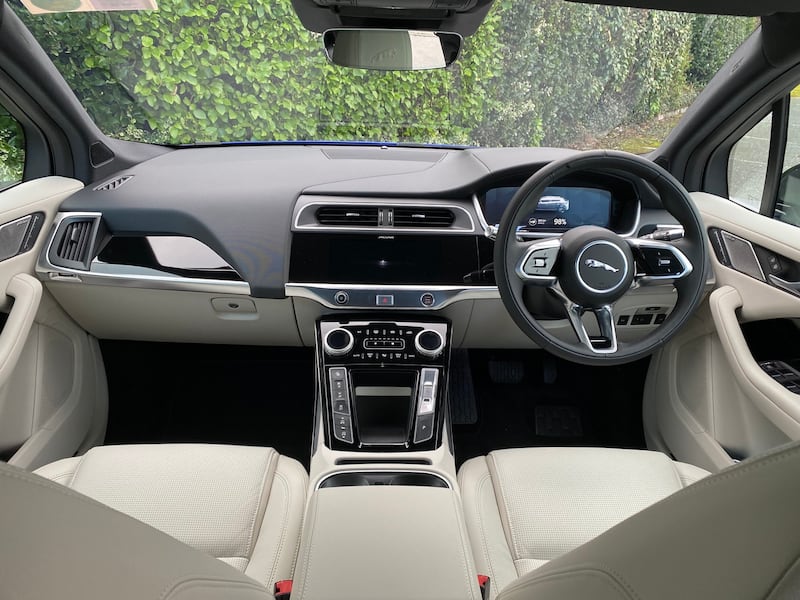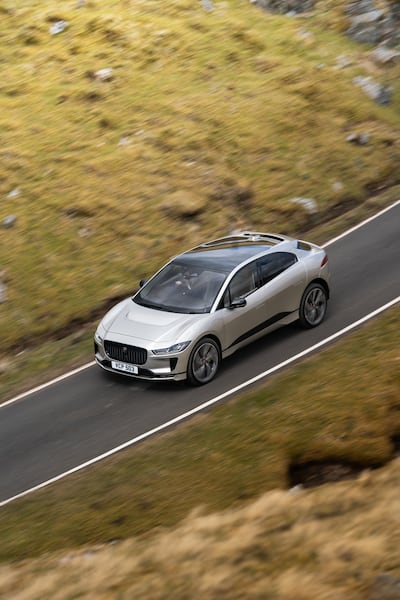There is just no way that the Jaguar I-Pace is already a four-year-old design. It's like my kids – they just can't possibly have aged that much, and the passing of time be damned. Still toddlers, the lot of them.
Alas, no. My kids are in their teens and the I-Pace was originally a 2018 model year car. Which in electric vehicle terms surely makes it more or less prehistoric, right?
After all, the Jaguar was effectively the first riposte to the challenge of Tesla to come from a mainstream car maker, and the first premium-badged SUV to actually go on sale with fully electric power. In that, the Jag was a full year ahead of rivals from Mercedes and Audi, and even further ahead of BMW, which is really only now starting to expand its electric line-up.

Shouldn’t that advantage then be a disadvantage now, though? I mean, if the I-Pace was the first major electric SUV to launch, then logic dictates that – given the rapid evolution and advancement of electric cars – it will now be well behind the times. Won’t it?
Certainly, looking at Jaguar’s updates granted to the I-Pace to keep it as fresh as possible, you’d have to think so. Mechanically, the I-Pace has changed not a jot. It still uses two electric motors to generate a very healthy 400hp and 696Nm of torque. It still uses the same 90kWh battery (although some software tweaks mean that more of the battery’s power is now accessible to the driver – some 84kWh worth).
The interior is all but unchanged – the only major updates being new digital dials and the new and hugely impressive Pivi Pro infotainment screen, a system that at last puts Jaguar right up with Merc, Audi, and BMW in screen terms. There's more mobile phone connectivity, too, including a handy remote cabin heat function.
On the range
There’s also an upgraded 11kW on-board charging system, which can add 53km of extra range in an hour from an AC charging point, while the maximum DC charging speed remains 100kW, adding 127km in 15 minutes. Total range on a full charge is a claimed 470km, and in real-world terms is more like 360km-390km, if it’s cold out and you’ve got the heating turned up.
So, that’s presumably well behind what the German rivals can offer, isn’t it? Well, not really. A BMW iX3 costs about the same as our I-Pace Black model test car (€74,940 for the Jag, €74,815 for the BMW) and goes about the same distance on a full charge, both in terms of claimed and real-world range. The iX3, though, has just a single electric motor with 286hp.
It’s more efficient overall than the Jag, extracting similar range from a battery that’s running on 10kWh less capacity, but it’s slower and not as much fun to drive. Ditto the Audi e-Tron Quattro. Double-ditto the Mercedes EQC.
It's certainly a far sexier-looking machine than anything to come out of Munich or Ingolstadt lately
That’s what’s so surprising about getting into the updated I-Pace in 2022 – it still feels, and broadly performs, bang up to date. Okay, so it could charge a little quicker ideally, and there’s not as much space in the back seats as you’ll find in, say, a (more expensive) BMW iX, but the Jag still feels utterly competitive in a market that should have left it behind.
For a start, it still looks brilliant. The Black model add-ons of shiny black wheels, badges and exterior trim add a mean edge to the I-Pace's handsome lines, and it's certainly a far sexier-looking machine than anything to come out of Munich or Ingolstadt lately – a testament to the pencil-wielding skills of the team, led by former head of Jag design Ian Callum, who created it.
Even the interior, which really ought to look and feel out of date by now, is actually pretty lovely. The architecture isn't as open-plan as you get in the new BMW iX, or a Tesla Model Y, but it's comfortable and simple to use (thanks to physical controls for heating and ventilation), and overall quality seems to be excellent. Possibly, that last advantage is down to this not being a UK-built Jaguar; it is actually made in Austria under contract by Magna-Steyr.
Well sprung
What really underpins the I-Pace’s modernity, though, is the way that it drives. Thanks to air suspension, although it’s quite firmly sprung, it generally glides rather than thumps, and it can keep its body movements under tight control when you find some twisty roads to drive it on.

While the BMW iX and Audi e-Tron quattro can similarly claim such a good combo of body control and ride, neither can get anywhere near the Jag when it comes to steering response and feel. Jaguar’s engineering team still has access to steering and handling witchcraft that seems to escape most rivals. The I-Pace feels far more agile and chuckable than any car weighing 2.2 tonnes ought to. It is nothing short of a delight to drive.
A big problem is that, in the electric world, the Jag badge doesn’t carry as much weight. Those of us who are car nuts, and still get misty-eyed about E-Types and XJ6s might crave a Jag badge, but most others will be seduced by the allure of Tesla, and no matter that the equivalent Model Y is nowhere near as pretty or well-made, and rides like it has bricks for springs.
Then there's the likes of the Hyundai Ioniq 5 and Kia EV6, which have better range, roomier cabins, are at least as stylish and cost €25,000 less. Think a humble Korean badge can't compete with a Jaguar? Electric motoring is a different world, my friend.
Even so, the I-Pace is a deeply tempting car, and that goes double now that we’ve realised that age has truly not wearied it. Somewhere, in an attic, there must be a painting of an I-Pace, gently rusting and leaking lubricant, while the real thing rolls around outside, still youthful.
LOWDOWN: JAGUAR I-PACE BLACK
Power: 294kW two-motor electric system developing 400hp and 696Nm of torque, driving a single-speed automatic transmission and four-wheel drive.
CO2 emissions (annual motor tax): 0g/km (€120).
Electric consumption: 22-25kWh/100km.
Battery capacity: 84kWh (net)
0-100km/h: 4.8sec.
Price: €74,940 as tested.
Our rating: 4/5.
Verdict: Should have been out of date by now, but it's still a stunner.











